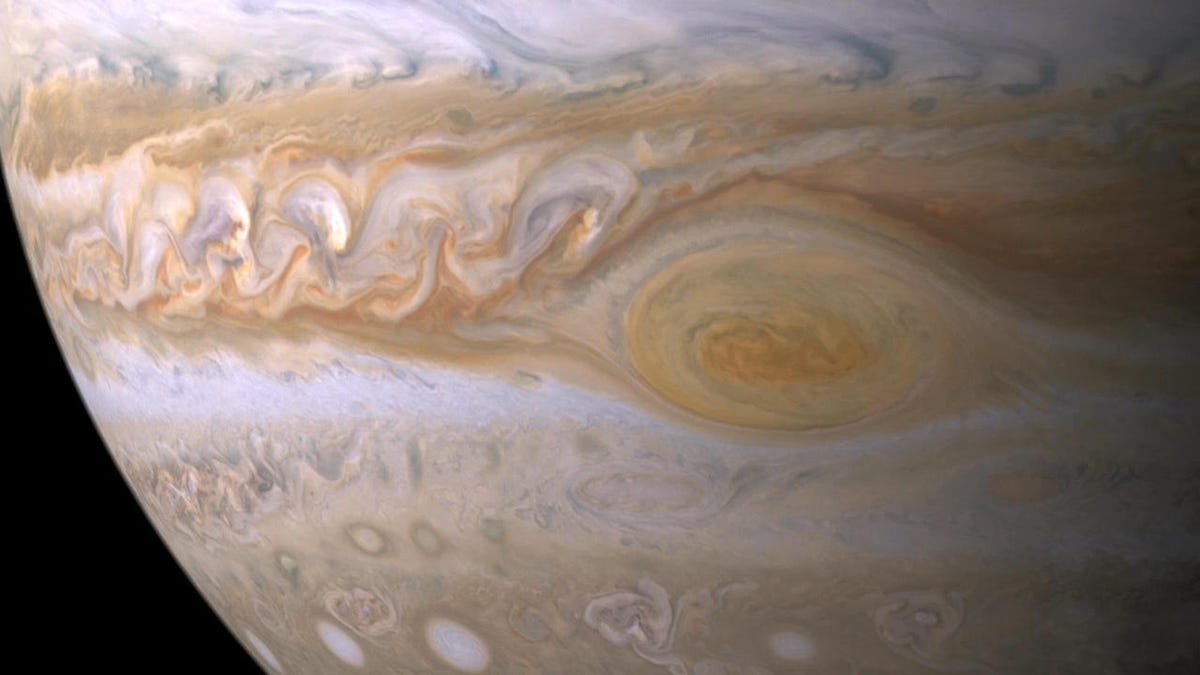NASA Spacecraft Images Watercolor Vortices Near Jupiter’s North Pole
Our solar system’s citrus-colored gas giant, Jupiter, is no stranger to chaos. And earlier this month, NASA’s Juno mission captured a mesmerizing snap to prove that point.
During the probe’s 43rd close flyby of the enormous planet, its JunoCam instrument caught sight of watercolor vortices near the north pole. These hypnotic views are deceptively stunning — they are of hurricane wind patterns that can reach over 30 miles (48 kilometers) in height and spread across hundreds of miles of gaseous plains.
Though the picture we see of the frightening spectacle is decked out in lovely ceruleans, iridescent opals and strong teals, it’s important to realize that it’s digitally processed to hold such vivid blue-ish hues. After collecting raw JunoCam data — specifically an image taken by the space explorer at about 15,600 miles (25,100 kilometers) above Jupiter’s cloud tops — citizen scientist Brian Swift enhanced these Jovian storms for analytic purposes.

The Juno spacecraft captured this Jupiter view in late May 2019.
NASA/JPL-Caltech/SwRI/MSSS/Kevin M. Gill
For instance, an achingly beautiful view of Jupiter and its moon, Ganymede, released earlier this year isn’t colorized in blue tones at all — and a composite image from last year might lead you to believe the Jovian lifestyle is shrouded in hellish flames. In reality, if we could hypothetically pop up next to Jupiter right now, we’d see those spirals projecting a variety of other colors – which fascinatingly depend on the chemistry and direction of each one.
Counterclockwise and clockwise cyclones in Jupiter’s northern hemisphere, as an example, offer their own separate palates. Counterclockwise and clockwise ones in the southern hemisphere also have their own. For context, Jupiter’s “Great Red Spot” is a southern hemisphere, counterclockwise storm.

This NASA image shows Jupiter’s Great Red Spot.
NASA/JPL/Space Science Institute
But apart from color schemes, scientists are also generally interested in understanding Jupiter’s stormy weather because such knowledge could help decode information about Jovian clouds and fluid dynamics in the atmosphere. This endeavor is so important, in fact, that NASA has been trying to outsource the job of categorizing storm images and other atmospheric phenomena of Jupiter.
You can even take part in what’s called the “Jovian Vortex Hunter” project online. All you need is access to a cellphone or laptop – so far, per the agency, 2,404 volunteers have contributed to study 376,725 images for the mission.
Zooming out, Jupiter is home to a great many mysteries, which is why the European Space Agency is poised to send its own probe toward the peach-striped ball of gas to join Juno’s cosmic expedition. Others have even tried to explore whether Jupiter’s nearly invisible, extremely frail rings could hold secrets to unlock the puzzles of this planet — to no avail.

-3.png?width=698&height=393&name=blog%20image%20Salima%20(1)-3.png)